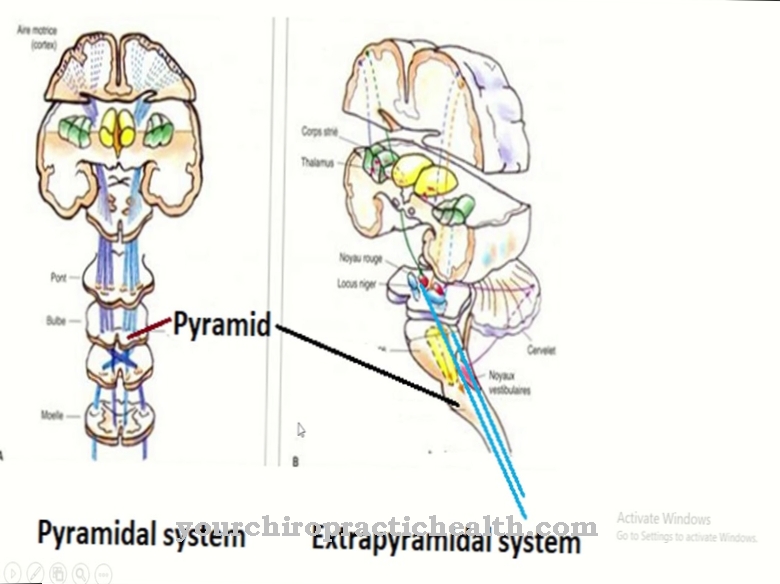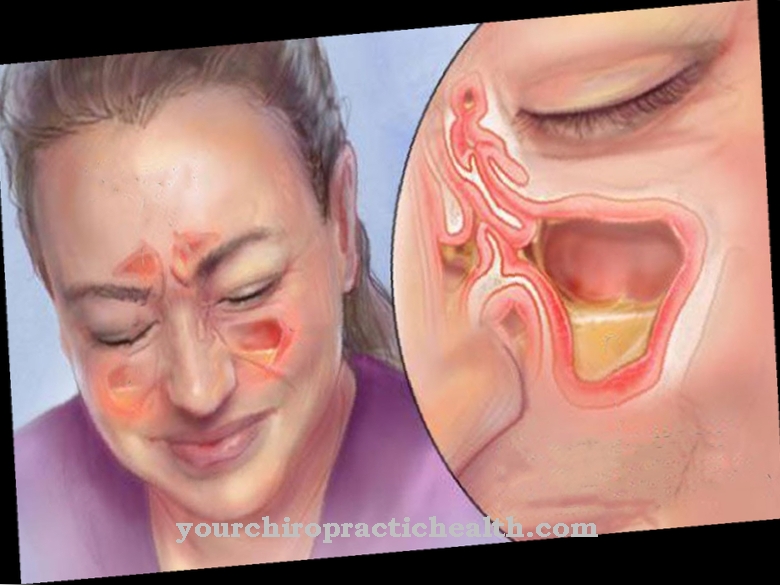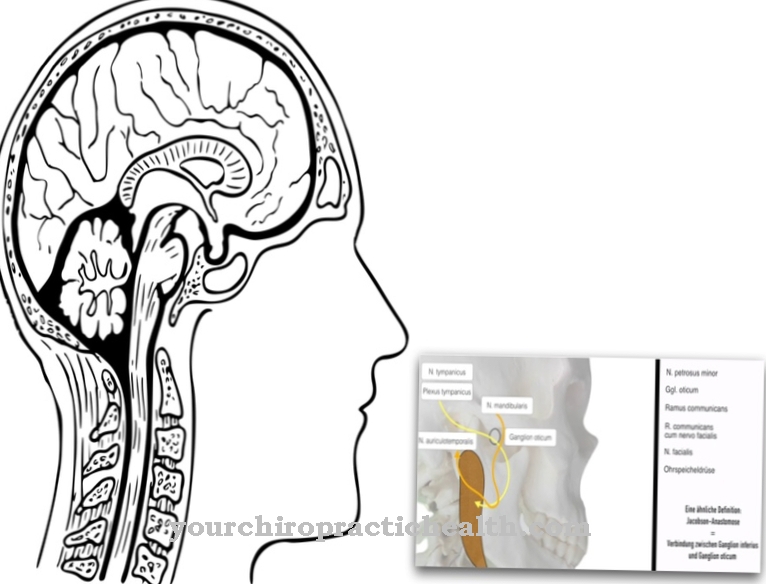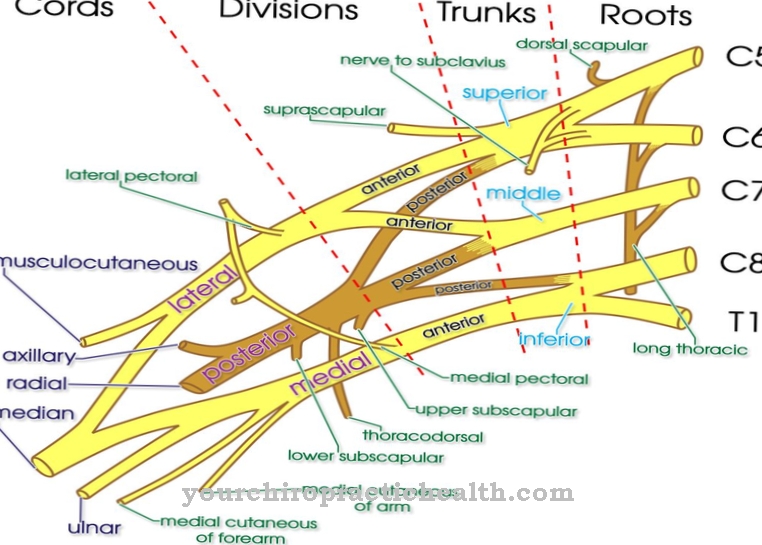Of the Thoracic duct As part of the lymphatic system, it is responsible for the transport of nutrients and waste materials. It collects the lymph from the two lower and upper left body quadrants and guides them back into the venous system. The thoracic duct carries the lymph through lymph nodes, which are an important part of the immune system and provide information about possible diseases in the diagnostic process.
What is the thoracic duct?
The name Ductus thoracicus is derived from the Latin word for gait and the Greek word for chest. As the largest lymph strain in the human body, it transports around three quarters of the total lymph fluid from the two lower and upper left quadrants of the body.
The lymph is a light yellow, watery liquid that contains cells and lymph plasma. In German, the term is synonymous for the thoracic duct Milk breast duct used. This is the result of the cloudy, milky quality of the lymph, which is created by the fats absorbed in the intestine after eating. This fatty lymph is also known as the chyle. The thoracic duct was first described medically in dogs in the 17th century, and a few years later also in humans.
Anatomy & structure
The thoracic duct arises in the cisterna chyli, the lumbar cistern. This point is often enlarged because this is where the lymph from the lower extremities, pelvis and abdomen converge. The three lymph trunks leading from the lower quadrants of the body are the paired lumbar trunk and the unpaired intestinal trunk.
The thoracic duct receives the lymph from these three vessels before it penetrates the diaphragm on the right behind the aorta. From there it runs along the spine up through the thorax and then runs in the neck area in an arc to the left venous angle. The junction is located near the confluence of the internal jugular vein and subclavian vein to the brachiocephalic vein. Shortly before the junction, the thoracic duct receives the bronchomediastinal trunk, the subclavian trunk and the jugular trunk.
These three vessels collect the lymph from the left quadrant of the body. A valve at the mouth prevents venous blood from entering the thoracic duct. Anatomically, the thoracic duct is comparable to a blood vessel, but the lumen of the lymphatic vessels for the transport of proteins and coagulated blood after injuries is larger
Function & tasks
As part of the lymphatic system, the thoracic duct complements the blood vessel system. It transports fluid that has not been absorbed by the blood vessels and returns it to the venous bloodstream. The lymph fluid in the thoracic duct transports proteins, fats, immune cells and water. After particularly high-fat meals, the fat concentration in the lymph is increased, which makes the lymph fluid cloudy and milky.
In front of the opening into the vein, there are lymph nodes through which the thoracic duct conducts the lymph fluid. There it is cleaned of foreign bodies, tumor cells and pathogens. Lymph nodes are also an essential part of the human immune system. Depending on the occurrence of pathogens in the lymph fluid, they activate and multiply antibodies. These are then released into the bloodstream to fight pathogens. If the activity is increased due to an infection or a tumor, the lymph node swells. During medical examinations, this provides information about the presence and type of the disease.
You can find your medication here
➔ Medicines to strengthen the defense and immune systemDiseases
Like all lymphatic vessels, the thoracic duct can be affected by congenital or acquired diseases. Lymphedema occurs when the return transport capacity is overwhelmed. The edema is an accumulation of fluid in the intercellular space.
This can occur as a symptom of an accompanying illness such as right heart failure. Lymphangitis, known colloquially as blood poisoning, can also affect the ductus arteriosus. It is an inflammation of the lymph usually caused by bacteria. The most noticeable outward symptom is a red stripe on the skin from the focus of inflammation. Enlarged lymph nodes appear in the corresponding area, and general symptoms such as fever can also occur.
Chronic lymphangitis can also cause lymphedema over time due to a drainage disorder. The lymphangioma is comparable to the hemangioma in the blood vessel system. It is a rare, benign tumor disease. The lymphangioma usually occurs in early childhood, although it is usually present at birth. In contrast to hemangiomas, lymphangiomas do not resolve on their own. Complete removal is necessary as any residue in the tissue will quickly recur. If the lymphangioma is not limited to a singular mass, but is spread throughout the body, then there is lymphangiomatosis. This disease causes the lymph vessels to proliferate in internal organs, bones, skin or soft tissue.
Lymphangiomatosis can cause fluid in the heart, abdomen, or lungs, as well as fever and internal bleeding. Other signs are massive pain and lymphedema. The prognosis depends heavily on the location and spread of the disease. In the case of lymphangiectasia, the lymph vessels also expand in the shape of a spindle, sack or tube. It can be congenital as a side effect of a syndrome or occur as part of an acquired disease. If the thoracic duct ruptures due to trauma, lymph fluid leaks into the chest cavity. If parenteral nutrition over several days does not lead to any improvement, surgical repair of the rupture is necessary.

























.jpg)

.jpg)
